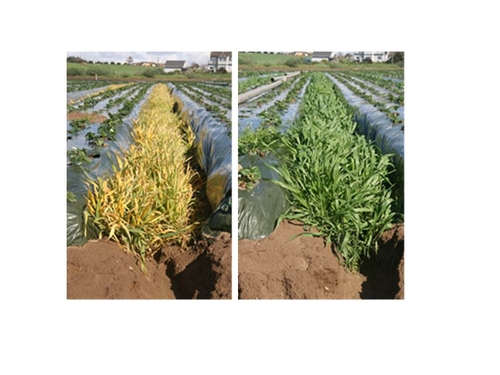Given the prospect of a strong El Niño this winter, a number of strawberry growers planted cover crops on the furrow bottoms to maximize infiltration into the soil and reduce erosion. Cover crops planted in late October or early November have now grown up even with the bed top and now is the time to control them to minimize shading of the strawberries which might affect yields. The control method depend on (1) the production system (conventional vs organic), (2) the type of cover crop (cereal vs mustard), (3) tractor access in the field, and (4) labor availability.
In one experiment, well managed furrow-bottom cover crops that were controlled before they shaded the strawberry plants, did not affect the yields of strawberries (Table 1). We have no data on what would happen is furrow bottom cover crops shaded strawberry plants, but seems likely that cover crops shading strawberry plants might slow their development and ultimately reduce the yield.
Table 1. Strawberry yield evaluations
(18 harvests from May 1 to June 29, 2007 Yields followed by the same lower case letter are not significantly different based on the least significant difference (LSD) at P=0.05.
Treatment | Yield (kg/plot) |
Control | 5.85 a |
Non winter dormant barley | 6.41 a |
Winter dormant triticale | 6.55 a |
Mechanical control options: Obtaining access to the fields when they are wet is a key concern and controlling the cover crop without damaging the plastic mulch is also important. Often the edges of the mulch extend down below the soil and may flair a bit towards the furrow which necessitates shallow or no tillage along the edge of the furrow. Planting the cover crop in a narrow band on the furrow bottom center may facilitate mechanical control by tillage because the implement can be adjusted tofocus just on the middle of the furrow; however, if the cover crop is rooted next to the edge of the plastic it will be more problematic to control with tillage. Cereal cover crops are hard to kill with tillage when the soil stays wet, as is often the case with strawberry furrows in the winter. Mustard cover crops are easier to kill with tillage because the stems are more brittle and uprooted plants have less tendency to reroot on wet soil.
Weed wacking is a great way to control and or kill mustard cover crops and has the advantage of not disturbing the soil. However, carefully managing the weed wacker to avoid damaging the plastic can be tricky. Some growers have found that in furrow bottoms, plastic or metal bladed weed wacker heads are easier to control than string weed wacker heads. Cutting the tops off of cereals will not kill them because the growing point are below the soil surface and it will be necessary to repeat the operation to control regrowth.
Pushing the mustard cover crops down into the furrow bottoms by walking on them or by driving a tractor on them may also be a way to prevent them from shading the bed tops but may require repeated management to be effective.
Chemical control options: Cereal cover crops can be controlled with grass selective herbicides that are registered on strawberries: clethodim (Select Max) and sethoxdim (Poast). These materials can be sprayed over the top of strawberries or as a directed spray towards the furrow. They are slow acting, but over a period of 10-14 days the plants will begin to yellow and eventually die (See photo below). Organic herbicides will not be an effective way to control cover crops in furrow bottoms.

Photo 1. Left: Barley treated with sethoxdim (Poast) (18 days after treatment) and Right: untreated cover crop.
Photo 2. Weed wacking Ida Gold mustard cover crops.